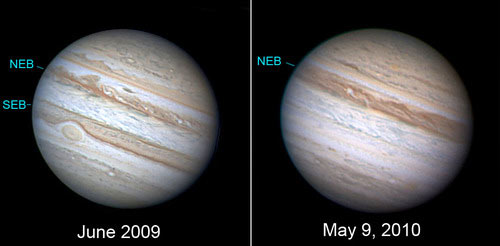Jupiter's Disappearing Cloud Stripe Mystifies Scientists

The disappearance of a giant cloud belt around the southern half of Jupiter has transformed the appearance of our solar system's largest planet and left scientists scratching their heads over what caused the huge brown stripe to vanish.
Photos taken May 9 by Australian amateur astronomer Anthony Wesley revealed that the huge rusty-hued band of clouds, known as the South Equatorial Belt (SEB), has faded from view. The trick for scientists now is explaining how it happened.
"This is a big event," said Glenn Orton, a planetary scientist at NASA's Jet Propulsion Laboratory, in a statement. "We're monitoring the situation closely and do not yet fully understand what's going on."
Jupiter's giant belt
Jupiter is wrapped in cloudy yellow, brown and white stripes, created by winds that blow at various latitudes and in different directions. The colors of the cloud bands reflect slight differences in chemical composition. Propelled by strong wind, these clouds can whip around the planet at hundreds of miles per hour.
High-elevation clouds can be found in the "belt" regions of Jupiter's atmosphere. Belt clouds are darker than those in the relatively low-elevation "zone" regions. The winds in belts and zones flow in opposite directions.
Jupiter's trademark Great Red Spot, a massive storm that could fit two Earths inside, is typically found along the edges of the planet's SEB.
Get the Space.com Newsletter
Breaking space news, the latest updates on rocket launches, skywatching events and more!
The SEB itself is also massive in size ? the cloudy band is twice as wide as Earth and more than 20 times as long. In fact, the loss of such an enormous "stripe" can be seen with ease halfway across the solar system with telescopes.
"In any size telescope, or even in large binoculars, Jupiter's signature appearance has always included two broad equatorial belts," Wesley said. "I remember as a child seeing them through my small backyard refractor and it was unmistakable. Anyone who turns their telescope on Jupiter at the moment, however, will see a planet with only one belt ? a very strange sight."
Wesley is a veteran Jupiter-watcher who discovered a dark blemish on the gas giant in July 2009 that turned out to be an impact on Jupiter, most likely from a comet. Wesley also spotted a giant blizzard on Saturn this year that is currently still going strong.
Where is Jupiter's cloud stripe?
Like other astronomers, Wesley noticed Jupiter's cloud belt fading late last year, "but I certainly didn't expect to see it completely disappear," he said. "Jupiter continues to surprise."
Orton believes that the belt has not completely disappeared. Rather, he suspects that the SEB could be shrouded beneath some higher clouds.
"It's possible that some 'ammonia cirrus' has formed on top of the SEB, hiding the SEB from view," Orton explained.
On Earth, cirrus clouds are made of ice crystals, and while the same sort of clouds can form on Jupiter, the crystals are composed of ammonia instead of water.
Orton believes that changes in global wind patterns could explain an abundance of "ammonia cirrus" clouds. Fluctuations in Jupiter's climate could bring ammonia-rich material into the clear, cold zone above the SEB, triggering the formation of high-altitude, icy clouds.
Still, the precise reason remains unknown. "I'd love to send a probe in there to find out what's really going on," Orton said.
Repeat performance
This is not the first time that the SEB has disappeared from view.?
"The SEB fades at irregular intervals, most recently in 1973-75, 1989-90, 1993, 2007, 2010," said John Rogers, director of the British Astronomical Association's Jupiter Section. "The 2007 fading was terminated rather early, but in other years the SEB was almost absent, as at present."
Scientists can, however, look forward to the SEB's return, which can be a dramatic experience.
"We can look forward to a spectacular outburst of storms and vortices when the 'SEB Revival' begins," Rogers said. "It always begins at a single point, and a disturbance spreads out rapidly around the planet from there, often becoming spectacular even for amateurs eyeballing the planet through medium-sized telescopes. However we can't predict when or where it will start. On historical precedent it could be any time in the next 2 years. We hope it will be in the next few months so that everyone can get a good view."
Jupiter, which is currently shining very bright in the eastern sky before sunrise, is no stranger to weird weather patterns.?
Last year, astronomers announced that Jupiter's Great Red Spot ? which has raged for at least 300 years ? appeared to be shrinking. In 2008, other smaller spot-like storms showed changes as well, while activity in the South Equatorial Belt also appeared to be slowing down.
Furthermore, earlier this year astronomers announced that Jupiter likely experiences occasional helium rain showers.
- Gallery - Jupiter Gets Slammed by a Comet
- The Wildest Weather in the Galaxy
- Jupiter Has Lost a Cloud Stripe, New Photos Reveal
Join our Space Forums to keep talking space on the latest missions, night sky and more! And if you have a news tip, correction or comment, let us know at: community@space.com.

Space.com is the premier source of space exploration, innovation and astronomy news, chronicling (and celebrating) humanity's ongoing expansion across the final frontier. Originally founded in 1999, Space.com is, and always has been, the passion of writers and editors who are space fans and also trained journalists. Our current news team consists of Editor-in-Chief Tariq Malik; Editor Hanneke Weitering, Senior Space Writer Mike Wall; Senior Writer Meghan Bartels; Senior Writer Chelsea Gohd, Senior Writer Tereza Pultarova and Staff Writer Alexander Cox, focusing on e-commerce. Senior Producer Steve Spaleta oversees our space videos, with Diana Whitcroft as our Social Media Editor.









